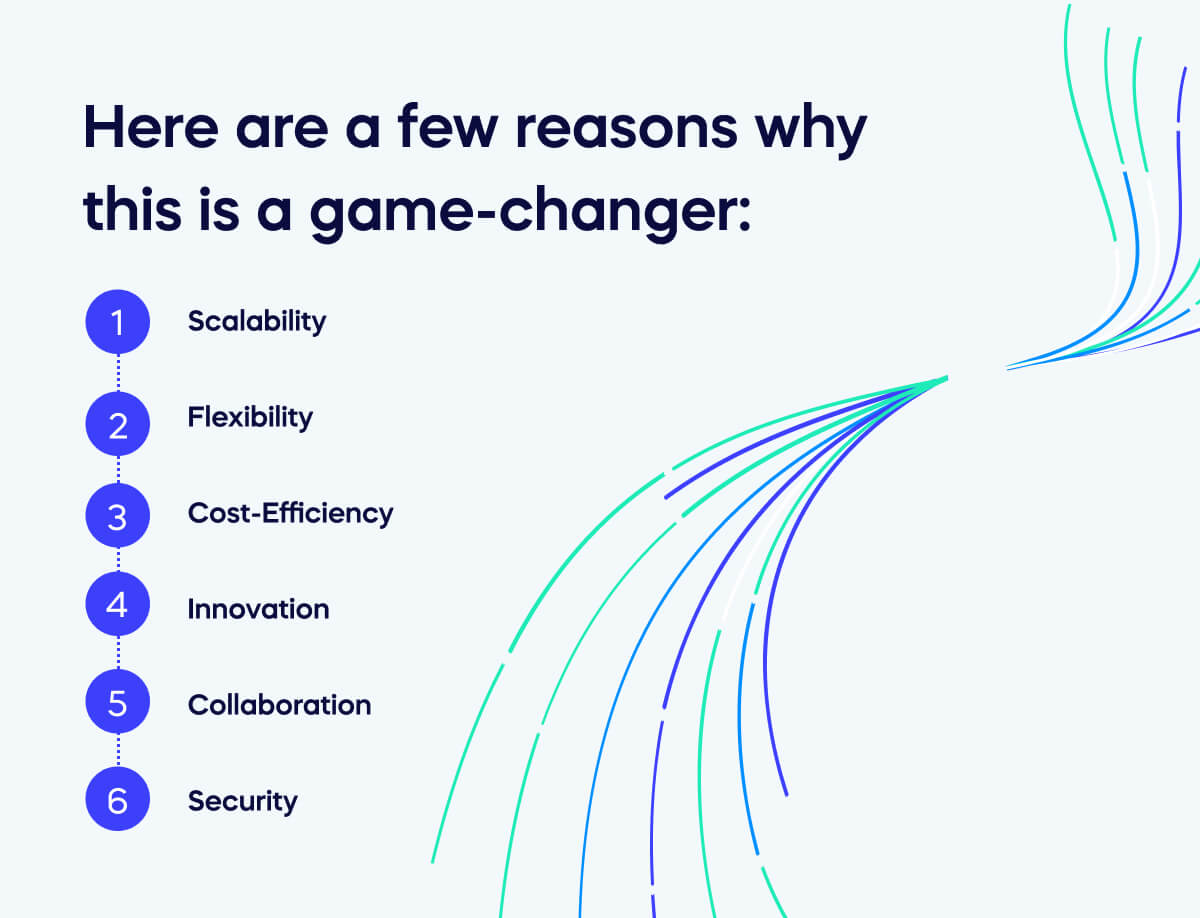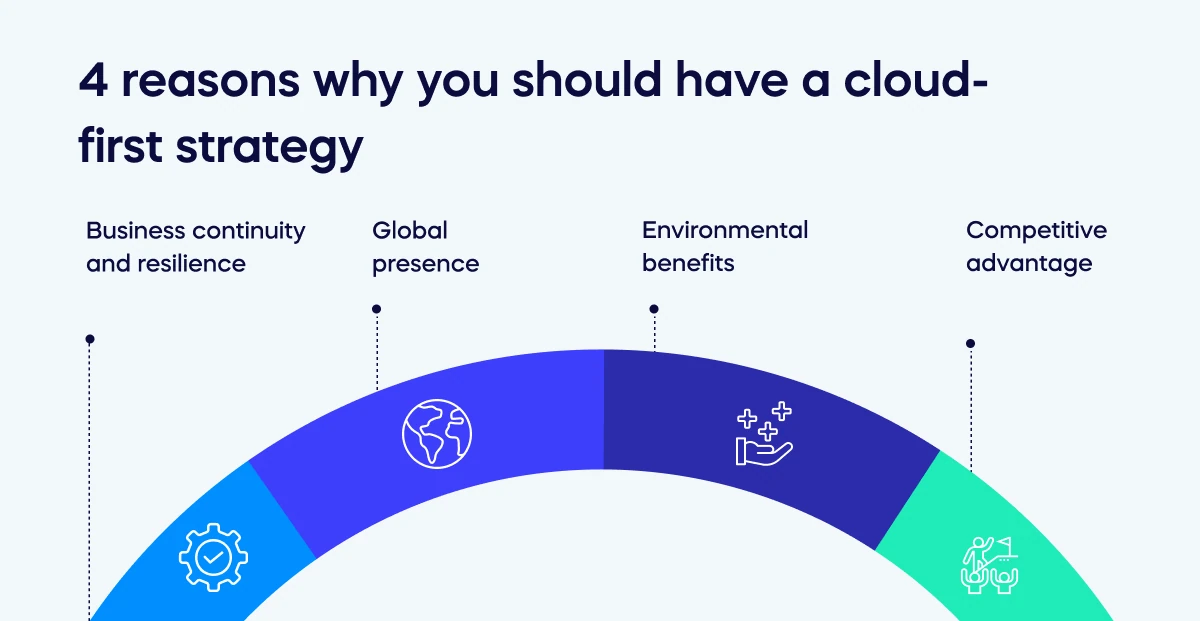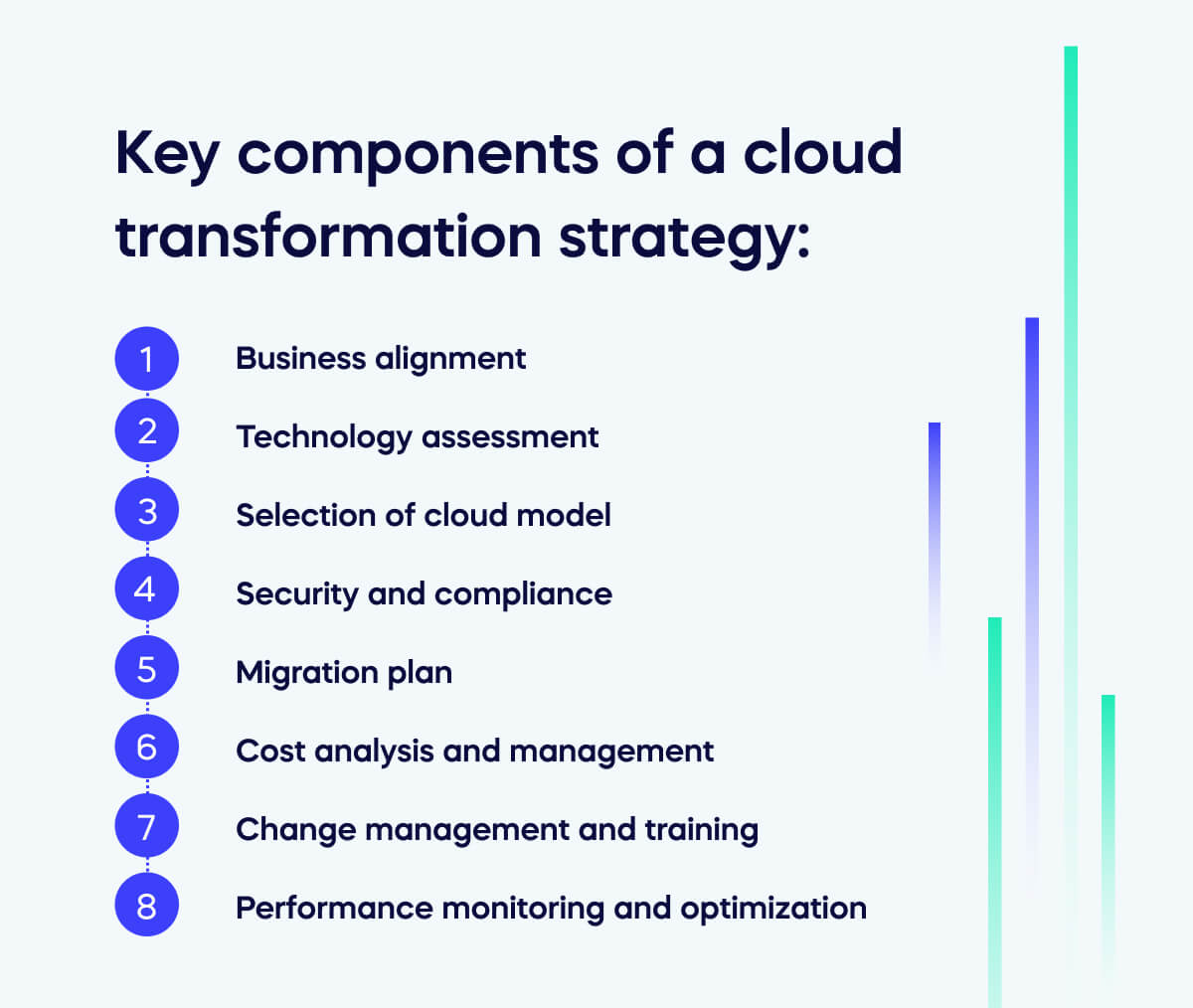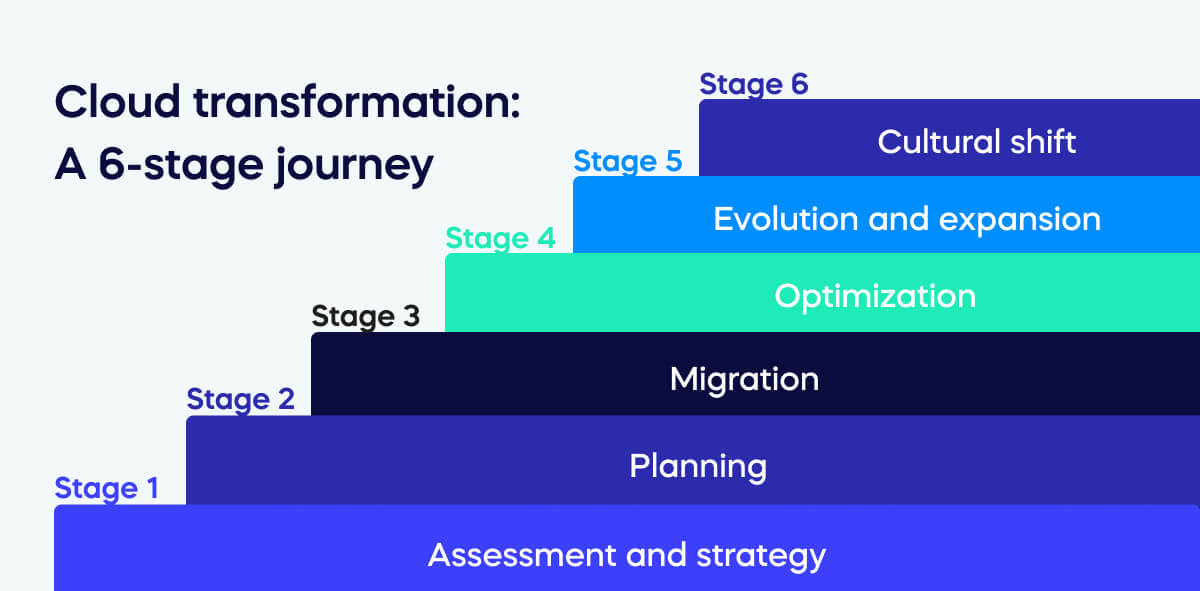What is cloud transformation?
Cloud transformation is the process of migrating work to the cloud, including data, apps, and software programs. IT infrastructure can also be migrated to the cloud in line with digital transformation objectives.

Table of contents
Cloud transformation enables businesses to quickly respond to threats and embrace new ways of working that incorporate the digital adoption of new technologies.
What is cloud-based digital transformation?
When you hear the term “cloud-based digital transformation,” you dive into modern business innovation’s heart.
Let’s break it down.
1. Digital transformation:
At its core, digital transformation is using digital technologies to create or modify existing business processes, culture, and customer experiences to meet changing business and market requirements.
It’s about reshaping your business model and strategy to leverage digital tools and thinking.
This transformation is not just about technology; it’s about changing the entire way you conduct business and deliver value to your customers.
2. The cloud:
The cloud refers to servers accessed over the Internet and the software and databases running on those servers.
Instead of buying or leasing physical servers, you rent computing power and storage from a cloud provider, often on a pay-as-you-go basis.
This offers flexibility, scalability, and cost efficiencies that traditional IT infrastructure can’t match.
Merging the two:
When you marry digital transformation with cloud technology, you’re harnessing the immense power and potential of the cloud to fuel and accelerate your transformation journey.
Here are a few reasons why this is a game-changer:

Scalability
With the cloud, you can easily scale your IT resources up or down based on demand.
This means you don’t have to overcommit on infrastructure expenses.
Flexibility
Cloud platforms support a multitude of services and applications.
Whether you want to implement artificial intelligence (AI), data analytics, or the Internet of Things (IoT), the cloud provides the necessary tools to pivot and adapt as your business needs to evolve.
Cost-Efficiency
By moving to the cloud, you can transition from a capital expenditure model (CapEx) to an operational expenditure model (OpEx).
This means you’re paying for what you use rather than sinking money into depreciating assets.
Innovation
Cloud providers regularly roll out new services and features.
As a business leader, this means you always have the latest tools at your fingertips to drive innovation and stay ahead of your competitors.
Collaboration
The cloud enables real-time collaboration.
Your teams can access, edit, and share documents and applications from anywhere, boosting productivity and fostering a culture of collaboration.
Security
Leading cloud providers invest significantly in security.
You enhance your data protection, compliance, and risk management by leveraging their expertise and infrastructure.
4 reasons why you should have a cloud-first strategy

A cloud-first strategy, where businesses prioritize the use of cloud services over traditional IT practices, has gained significant traction among organizations of all sizes.
For forward-thinking business leaders, understanding its benefits is pivotal.
On top of the benefits listed above, here are 4 more benefits of a cloud-first strategy:
Business continuity and resilience:
Cloud services offer effective disaster recovery and backup solutions.
This ensures minimal downtime and data loss in the face of unforeseen events, be it technical failures or natural disasters.
They’re a key element in modern business continuity planning.
Global presence:
By leveraging cloud providers’ vast network of data centers, you can deploy your applications and services close to your target audience, ensuring optimal performance and user experience globally.
Environmental benefits:
Using shared cloud resources can lead to a smaller carbon footprint than maintaining individual, on-premises data centers.
It’s a step towards sustainable and environmentally responsible operations.
Competitive advantage:
A cloud-first approach ensures you are agile, flexible, and always leveraging the best technologies.
This can significantly enhance your market positioning, allowing you to respond to market changes faster than competitors.
What is a cloud transformation strategy?
Cloud transformation is a major component of the digital transformation umbrella and has helped to revolutionize the online space.
A cloud transformation strategy is simply the approach you take to make your transition to the cloud as seamless as possible.
It can be as simple as using an established digital transformation model to keep your cloud transformation on track.
Key components of a cloud transformation strategy

Business alignment:
- Understanding objectives: Define the goals you aim to achieve through cloud transformation, such as cost reduction, agility, or innovation.
- Align with business goals: Ensure the transformation aligns with and supports your overall business strategy.
Technology assessment:
- Current state analysis: Review your existing IT landscape, including hardware, software, data, and integration points.
- Compatibility analysis: Determine which applications and data can move to the cloud without significant modifications.
Selection of cloud model:
- Public, private, or hybrid: Determine the best cloud model for your organization based on factors such as compliance, scalability, and budget.
Security and compliance:
- Risk management: Identify and address potential security risks.
- Compliance standards: Ensure adherence to regulatory and industry standards.
Migration plan:
- Migration framework: Layout the process for migrating assets, including tools, methods, and timelines.
- Testing strategy: Plan thorough testing to ensure functionality post-migration.
Cost analysis and management:
- Budgeting: Determine the budget, factoring in both immediate and long-term costs.
- Ongoing cost monitoring: Use tools and processes to monitor and manage ongoing cloud expenses.
Change management and training:
- Communication plan: Develop a strategy to communicate changes and expectations to stakeholders.
- Training programs: Equip your team with the necessary skills and knowledge through employee training.
Performance monitoring and optimization:
- Monitoring tools: Adopt tools that continuously monitor performance.
- Optimization strategy: Regularly review and optimize to ensure efficiency and alignment with evolving business needs.
Why is it important?
A cloud transformation strategy isn’t merely a technical roadmap; it’s a business strategy.
By having a well-defined plan, you achieve:
Alignment with business goals: Your steps in the cloud journey support your broader business strategy.
Risk mitigation: Potential risks are identified early with plans in place to address them.
Efficient resource utilization: You can effectively allocate resources, balancing costs and maximizing ROI.
Smooth transition: A well-laid-out strategy ensures minimal disruption during migration.
What is a cloud transformation journey?
The cloud transformation journey refers to the process through which your organization transitions systems, applications, data, and operations from on-premises infrastructure to cloud environments or from one cloud environment to another.
More than just a data movement, it embodies a holistic approach incorporating strategy, culture, process, and technological shifts.
Cloud transformation: A 6-stage journey

1. Assessment and strategy:
- Evaluate your current IT infrastructure, applications, and data.
- Set clear objectives to understand what you aim to achieve with the transformation, such as cost savings, agility, or scalability.
- Recognize potential challenges and create strategies to mitigate them.
2. Planning:
- Determine the most suitable cloud model for your needs: public, private, hybrid, or multi-cloud.
- Understand the costs involved, considering both upfront and recurring expenses.
- Ensure your team is equipped with the necessary skills and tools for the migration.
3. Migration:
- Decide the order in which applications and workloads should be moved. It’s often wise to test the process with less critical applications.
- Execute the migration, which might involve lifting and shifting, refactoring, or even rebuilding applications for the cloud.
- Test the migrated applications rigorously to ensure they run seamlessly in the cloud environment.
4. Optimization:
- Continuously monitor the performance of your applications in the cloud.
- Keep a check on costs to ensure efficient use of resources.
- Explore opportunities to leverage additional cloud-native tools to enhance efficiency and value.
5. Evolution and expansion:
- As cloud providers introduce new services, consider integrating them into your operations.
- Remember, cloud transformation is an ongoing process. Regularly revisit your strategy and adjust as needed.
- As you gain confidence and expertise, expand your cloud operations and integrate cloud capabilities across different business facets.
6. Cultural shift:
- Foster a cloud-first mindset within your organization.
- Prioritize continuous learning as the cloud domain evolves rapidly.
Frequently asked questions
A cloud-computing service refers to services delivered over the internet, allowing you to access computing resources without managing or owning the underlying infrastructure. These services include storage, computing power, databases, networking, analytics, and more. By leveraging cloud-computing services, businesses can scale resources based on demand, pay only for what they use, and avoid the complexities and costs associated with owning and maintaining on-premises infrastructure.
A cloud transformation roadmap is a strategic plan that outlines the step-by-step approach an organization takes to migrate its digital assets, processes, and operations to the cloud. It serves as a guide, detailing phases, milestones, tasks, and timelines, ensuring a smooth and efficient transition. This roadmap is crucial for aligning technical actions with overarching business objectives, anticipating challenges, and ensuring stakeholder buy-in throughout the transformation journey.
Cloud migration refers to moving data, applications, or other business elements from an on-premises infrastructure or a legacy platform to a cloud environment. It’s essentially a shift in location. Cloud transformation, on the other hand, is a broader concept. While it includes migration, it also encompasses the fundamental change in how an organization operates and delivers value to its customers using cloud technologies. This can involve re-architecting applications to be cloud-native, changing business processes, or even shifting the business model. In essence, while cloud migration is about the “move,” cloud transformation is about the “change and innovation” enabled by the cloud.
Yes, the cloud is a form of digital technology. It provides computing resources— like storage, processing power, and networking— over the internet. Cloud technology enables organizations to use software, hardware, and other services on a pay-as-you-go basis without owning or operating the physical infrastructure. This digital approach allows for enhanced flexibility, scalability, and efficiency compared to traditional IT setups.
Multi-cloud is a strategy where a business uses multiple cloud services from different cloud providers. This can include a mix of public and private clouds. Multi-cloud is a popular approach— a study by Gartner revealed that 76% of cloud customers use more than one cloud provider. By adopting a multi-cloud approach, organizations aim to reduce dependency on a single provider, optimize costs, enhance performance by leveraging best-of-breed services, and increase flexibility and resilience. It also allows businesses to pick and choose specific services from various providers that best meet their unique needs and objectives.